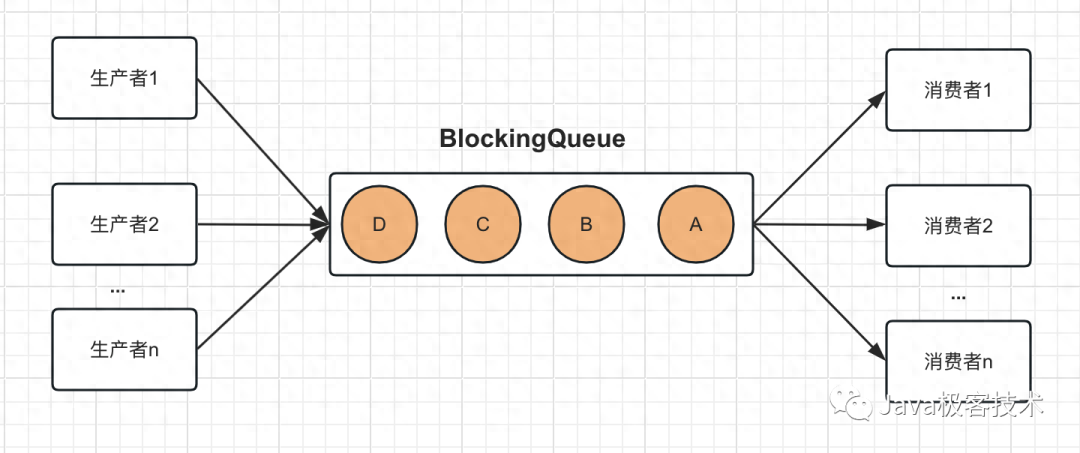一、摘要
在之前的文章中,我们介绍了生产者和消费者模型的最基本实现思路,相信大家对它已经有一个初步的认识。
在 Java 的并发包里面还有一个非常重要的接口:BlockingQueue。
BlockingQueue是一个阻塞队列,更为准确的解释是:BlockingQueue是一个基于阻塞机制实现的线程安全的队列。通过它也可以实现生产者和消费者模型,并且效率更高、安全可靠,相比之前介绍的生产者和消费者模型,它可以同时实现生产者和消费者并行运行。

那什么是阻塞队列呢?
简单的说,就是当参数在入队和出队时,通过加锁的方式来避免线程并发操作时导致的数据异常问题。
在 Java 中,能对线程并发执行进行加锁的方式主要有synchronized和ReentrantLock,其中BlockingQueue采用的是ReentrantLock方式实现。
与此对应的还有非阻塞机制的队列,主要是采用 CAS 方式来控制并发操作,例如:ConcurrentLinkedQueue,这个我们在后面的文章再进行分享介绍。
今天我们主要介绍BlockingQueue相关的知识和用法,废话不多说了,进入正题!
二、BlockingQueue 方法介绍
打开BlockingQueue的源码,你会发现它继承自Queue,正如上文提到的,它本质是一个队列接口。
关于队列,我们在之前的集合系列文章中对此有过深入的介绍,本篇就再次简单的介绍一下。
队列其实是一个数据结构,元素遵循先进先出的原则,所有新元素的插入,也被称为入队操作,会插入到队列的尾部;元素的移除,也被称为出队操作,会从队列的头部开始移除,从而保证先进先出的原则。
在Queue接口中,总共有 6 个方法,可以分为 3 类,分别是:插入、移除、查询,内容如下:
方法描述add(e)插入元素,如果插入失败,就抛异常offer(e)插入元素,如果插入成功,就返回 true;反之 falseremove()移除元素,如果移除失败,就抛异常poll()移除元素,如果移除成功,返回 true;反之 falseelement()获取队首元素,如果获取结果为空,就抛异常peek()获取队首元素,如果获取结果为空,返回空对象
因为BlockingQueue是Queue的子接口,了解Queue接口里面的方法,有助于我们对BlockingQueue的理解。
除此之外,BlockingQueue还单独扩展了一些特有的方法,内容如下:
方法描述put(e)插入元素,如果没有插入成功,线程会一直阻塞,直到队列中有空间再继续offer(e, time, unit)插入元素,如果在指定的时间内没有插入成功,就返回 false;反之 truetake()移除元素,如果没有移除成功,线程会一直阻塞,直到队列中新的数据被加入poll(time, unit)移除元素,如果在指定的时间内没有移除成功,就返回 false;反之 truedrainTo(Collection c, int maxElements)一次性取走队列中的数据到 c 中,可以指定取的个数。该方法可以提升获取数据效率,不需要多次分批加锁或释放锁
分析源码,你会发现相比普通的Queue子类,BlockingQueue子类主要有以下几个明显的不同点:
- 1.元素插入和移除时线程安全:主要是通过在入队和出队时进行加锁,保证了队列线程安全,加锁逻辑采用ReentrantLock实现
- 2.支持阻塞的入队和出队方法:当队列满时,会阻塞入队的线程,直到队列不满;当队列为空时,会阻塞出队的线程,直到队列中有元素;同时支持超时机制,防止线程一直阻塞
三、BlockingQueue 用法详解
打开源码,BlockingQueue接口的实现类非常多,我们重点讲解一下其中的 5 个非常重要的实现类,分别如下表所示。
实现类功能ArrayBlockingQueue基于数组的阻塞队列,使用数组存储数据,需要指定长度,所以是一个有界队列LinkedBlockingQueue基于链表的阻塞队列,使用链表存储数据,默认是一个无界队列;也可以通过构造方法中的capacity设置最大元素数量,所以也可以作为有界队列SynchronousQueue一种没有缓冲的队列
生产者产生的数据直接会被消费者获取并且立刻消费PriorityBlockingQueue基于优先级别的阻塞队列,底层基于数组实现,是一个无界队列DelayQueue延迟队列,其中的元素只有到了其指定的延迟时间,才能够从队列中出队
下面我们对以上实现类的用法,进行一一介绍。
3.1、ArrayBlockingQueue
ArrayBlockingQueue是一个基于数组的阻塞队列,初始化的时候必须指定队列大小,源码实现比较简单,采用的是ReentrantLock和Condition实现生产者和消费者模型,部分核心源码如下:
ArrayBlockingQueue采用ReentrantLock进行加锁,只有一个ReentrantLock对象,这意味着生产者和消费者无法并行运行。
我们看一个简单的示例代码如下:
运行结果如下:
可以很清晰的看到,生产者线程执行完毕之后,消费者线程才开始消费。
3.2、LinkedBlockingQueue
LinkedBlockingQueue是一个基于链表的阻塞队列,初始化的时候无须指定队列大小,默认队列长度为Integer.MAX_VALUE,也就是 int 型最大值。
同样的,采用的是ReentrantLock和Condition实现生产者和消费者模型,不同的是它使用了两个lock,这意味着生产者和消费者可以并行运行,程序执行效率进一步得到提升。
部分核心源码如下:
把最上面的样例Container中的阻塞队列实现类换成LinkedBlockingQueue,调整如下:
再次运行结果如下:
可以很清晰的看到,生产者线程和消费者线程,交替并行执行。
3.3、SynchronousQueue
SynchronousQueue是一个没有缓冲的队列,生产者产生的数据直接会被消费者获取并且立刻消费,相当于传统的一个请求对应一个应答模式。
相比ArrayBlockingQueue和LinkedBlockingQueue,SynchronousQueue实现机制也不同,它主要采用队列和栈来实现数据的传递,中间不存储任何数据,生产的数据必须得消费者处理,线程阻塞方式采用 JDK 提供的LockSupport park/unpark函数来完成,也支持公平和非公平两种模式。
- 当采用公平模式时:使用一个 FIFO 队列来管理多余的生产者和消费者
- 当采用非公平模式时:使用一个 LIFO 栈来管理多余的生产者和消费者,这也是SynchronousQueue默认的模式
部分核心源码如下:
同样的,把最上面的样例Container中的阻塞队列实现类换成SynchronousQueue,代码如下:
再次运行结果如下:
可以很清晰的看到,生产者线程和消费者线程,交替串行执行,生产者每投递一条数据,消费者处理一条数据。
3.4、PriorityBlockingQueue
PriorityBlockingQueue是一个基于优先级别的阻塞队列,底层基于数组实现,可以认为是一个无界队列。
PriorityBlockingQueue与ArrayBlockingQueue的实现逻辑,基本相似,也是采用ReentrantLock来实现加锁的操作。
最大不同点在于:
- 1.PriorityBlockingQueue内部基于数组实现的最小二叉堆算法,可以对队列中的元素进行排序,插入队列的元素需要实现Comparator或者Comparable接口,以便对元素进行排序
- 2.其次,队列的长度是可扩展的,不需要显式指定长度,上限为Integer.MAX_VALUE - 8
部分核心源码如下:
同样的,把最上面的样例Container中的阻塞队列实现类换成PriorityBlockingQueue,调整如下:
生产者插入数据的内容,我们改下插入顺序。
最后运行结果如下:
从日志上可以很明显看出,对于整数,默认情况下,按照升序排序,消费者默认从 0 开始处理。
3.5、DelayQueue
DelayQueue是一个线程安全的延迟队列,存入队列的元素不会立刻被消费,只有到了其指定的延迟时间,才能够从队列中出队。
底层采用的是PriorityQueue来存储元素,DelayQueue的特点在于:插入队列中的数据可以按照自定义的delay时间进行排序,快到期的元素会排列在前面,只有delay时间小于 0 的元素才能够被取出。
部分核心源码如下:
同样的,把最上面的样例Container中的阻塞队列实现类换成DelayQueue,代码如下:
DelayQueue队列中的元素需要显式实现Delayed接口,定义一个DelayedUser类,代码如下:
生产者插入数据的内容,做如下调整。
最后运行结果如下:
可以很清晰的看到,延迟时间最低的排在最前面。
四、小结
最后我们来总结一下BlockingQueue阻塞队列接口,它提供了很多非常丰富的生产者和消费者模型的编程实现,同时兼顾了线程安全和执行效率的特点。
开发者可以通过BlockingQueue阻塞队列接口,简单的代码编程即可实现多线程中数据高效安全传输的目的,确切的说,它帮助开发者减轻了不少的编程难度。
在实际的业务开发中,其中LinkedBlockingQueue使用的是最广泛的,因为它的执行效率最高,在使用的时候,需要平衡好队列长度,防止过大导致内存溢出。
举个最简单的例子,比如某个功能上线之后,需要做下压力测试,总共需要请求 10000 次,采用 100 个线程去执行,测试服务是否能正常工作。如何实现呢?
可能有的同学想到,每个线程执行 100 次请求,启动 100 个线程去执行,可以是可以,就是有点笨拙。
其实还有另一个办法,就是将 10000 个请求对象,存入到阻塞队列中,然后采用 100 个线程去消费执行,这种编程模型会更佳灵活。
具体示例代码如下:
本文主要围绕BlockingQueue阻塞队列接口,从方法介绍到用法详解,做了一次知识总结,如果有描述不对的地方,欢迎留言指出!




































